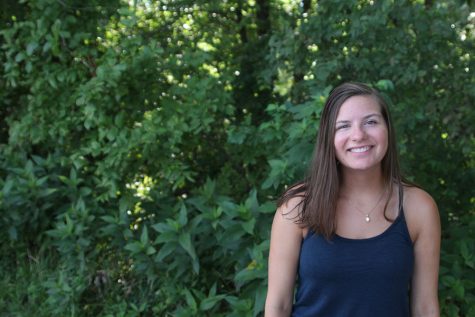Survey administered to assess student well-being
Results will be used as baseline for accreditation process
Contemplating his responses, junior Jack Mahoney takes the district survey in seminar on Wednesday, October 25.
October 27, 2017
Students throughout the district took a survey from Tuesday, Oct. 24 to Thursday, Oct. 26, answering questions about social-emotional feelings toward school. The survey is part of new accreditation standards set by the state regarding the well-being of students while at school. The survey was created by Greenbush, an education service center based out of the southeast side of the state, and was administered to every student in grades 3-12.
Associate principal Jennifer Smith was in charge of organizing the survey distribution for the school, and explained that the survey was one part of a larger, new accreditation process.
“The state has adopted new social-emotional character development standards for part of the accreditation process,” Smith said. “Not only are they asking schools to measure and work towards the academic achievement, but really looking at the whole child, looking at the social-emotional pieces to see where we are as a district. It’s really to set that baseline so we know where we need to make improvements and areas we need to address.”
Junior Carly Tribble said the survey was quick and simple to take.
“They kind of want to get an idea on what kind of student you are,” Tribble said. “And if you feel like you can set goals and meet them because of school. I felt like it was really easy, just because the questions were really straightforward.”
For junior Elizabeth Rigney, the survey was not particularly entertaining, but had useful information.
“It was OK,” Rigney said. “I mean, it was just a survey. It wasn’t like it was really fun. There were a lot of questions about how much you try in school and how much you can change the effort you put in, also about how much you control your emotions at school.”
The questions may have been personal, but left no way for anyone interpreting results to identify specific groups. Smith said the high school results will be combined with DHS and then broken up into grade level from there.
“What’s very interesting is there really are no individual descriptors or demographics collected on anyone, so the information that we receive back is going to be in broad chunks,” Smith said. “They’ll be able to do it by grade level, then grouped by high school, middle school and elementary. That’s as specific as it can get.”
The survey was administered during seminar, leaving a closed seminar for three days. This means that students were not able to travel to any other rooms or go to Math Lab. Despite the time taken out of the day, Tribble said that students may answer the questions carelessly just to get the survey completed.
“I feel like a lot of kids will just answer whatever comes to mind first rather than really think for a while about their answers,” Tribble said. “You might get an OK estimate from the school, but a lot of kids, even though it’s anonymous, won’t put the full, true answer. They’re just like, ‘Oh, this OK, I’ll click this one’ just to get it done quickly.”
Rigney felt the closed seminar played a role in this.
“I feel like it was a little useless to have a closed seminar for a survey that took maybe five minutes, when there’s other stuff you had to do, like assignments and going to other teachers to get stuff,” Rigney said.
As a solution, Tribble suggested that the survey should be administered differently in the future.
“Maybe if you picked one of the core classes, that would be a better place,” Tribble said. “If you said that all English students have to do it, kind of like how we do MAP testing.”
As far as results go, the comprehensive nature of the survey only allows for broad interpretation, but Smith said students and parents will be able to read results once they become public record.
“The information that we do receive will not be something you can narrow down, but the results are information we will be sharing with the Board of Education,” Smith said. “Usually anything that’s shared with the Board of Education is public record. It will also be shared during the district site council meeting, so the information will be out there and anything that is shared during those meetings are open record.”
Though it is up to the Board as to when those results will be discussed, Smith explained they are to receive the results next week and will be a helpful part of district growth.
“It’s information that we’re going to get very quickly; it’s a quick turnaround,” Smith said. “I know that when we look at our goals for the district, we’re really trying to look at that and start identifying those for the next year.”










